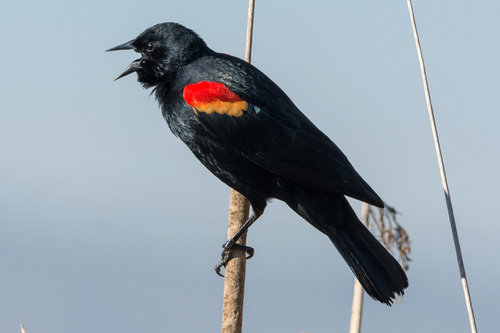
Red-winged Blackbird
The Red-winged Blackbird (Agelaius phoeniceus) is a highly recognizable and widespread passerine bird native to North and Central America. Known for the male's striking black plumage with vibrant red and yellow shoulder patches (epaulets), it plays a significant role in its ecosystem as both a seed disperser and an insect predator. While not holding specific cultural significance in many areas, its conspicuous presence and distinctive calls make it a familiar symbol of wetlands and open fields. It is one of the most abundant landbirds in North America.
17-23 cm
Length
28-40 cm
Wingspan
Least Concern
Conservation Status
Distribution
The Red-winged Blackbird breeds across most of North America, from Alaska and Canada south to Mexico and parts of Central America. Northern populations are migratory, wintering in the southern United States and south along both coasts. Some populations in the southern part of their range are resident year-round. They have an altitudinal range from sea level to over 2,500 meters.
Lifespan
The average lifespan in the wild is about 2 years, although some individuals have been recorded living over 15 years.
Red-winged Blackbird's Habitat
Habitat Types
Marshes, Wetlands, Fields, Agricultural areas, Roadsides
Climate Zones
Temperate, Subtropical, Tropical
Adaptations
Red-winged Blackbirds are highly adaptable to various wetland and open habitats. Their broad diet allows them to thrive in different environments. Their strong legs and feet are well-suited for perching on reeds and cattails, common vegetation in their preferred habitats.
Variations
Numerous subspecies (up to 25) are recognized, differing primarily in size and the coloration of the females. Some island populations, like those in California, show subtle variations in the male's epaulet color.
Appearance
Breeding Plumage
Breeding males are glossy black with bright red shoulder patches (epaulets) bordered by yellow. Non-breeding males have duller plumage, with the red often partially concealed. Females are streaked brown and buff, resembling large sparrows.
Seasonal Feather Changes
The most significant seasonal variation is the dulling of the male's plumage in the non-breeding season. The intensity of the red and yellow epaulets can also vary.
Sex Based Plumage Differences
Strong sexual dimorphism is present. Males and females have vastly different plumage, as described above.
Notable Features
Bright red and yellow epaulets on males (breeding plumage), Strong, pointed bill, Streaked brown plumage in females
Diet and Feeding
Primary Foods
Insects, Seeds, Grains, Spiders
Foraging Behavior
Red-winged Blackbirds forage on the ground, in vegetation, and sometimes by hawking insects in the air. They often glean insects from plants and probe the ground for seeds. During the breeding season, they are primarily insectivorous, feeding their young a protein-rich diet.
Specializations
Their strong, conical bill is well-suited for both cracking seeds and capturing insects. They are opportunistic feeders, adapting their diet to available resources.
Seasonal Diet Variations
Their diet shifts seasonally. Insects are the primary food source during the breeding season, while seeds and grains become more important in the fall and winter.
Behavior
Social Structure
Highly social, especially outside the breeding season. Forms large flocks, sometimes numbering in the thousands, for roosting and foraging. During the breeding season, males are highly territorial.
Communication
Distinctive "conk-la-ree" song of the male, Various calls and alarm notes, Visual displays, including spreading wings and displaying epaulets
Migration
Northern populations are migratory, traveling south for the winter. Migration is often triggered by changes in day length and food availability. They migrate in large flocks, often mixed with other blackbird species.
Territorial or Group Behaviors
Males are fiercely territorial during the breeding season, defending their nesting areas against rivals. Outside of breeding, they are highly gregarious and form large roosting flocks.
Conservation
Threats
Habitat loss (wetland drainage), Pesticide use, Collisions with vehicles and structures
Protection Programs
Migratory Bird Treaty Act (in the US), Wetland conservation initiatives
Local National Laws
Protected under the Migratory Bird Treaty Act in the United States and similar legislation in Canada and Mexico.
Population Trend
Stable
Population Estimates
Estimated global population is around 190 million individuals.
Interesting Facts
Males can have up to 15 different females nesting within their territory.
This polygynous mating system is driven by the male's ability to defend high-quality nesting habitat.
Red-winged Blackbirds are one of the most studied bird species in North America.
Their abundance and ease of observation make them ideal subjects for research on behavior, ecology, and evolution.
They sometimes form mixed-species flocks with other blackbirds and grackles.
These large flocks can cause significant damage to agricultural crops, particularly grains.
Faqs about Red-winged Blackbird
What do Red-winged Blackbirds eat?
They eat a variety of insects, seeds, and grains. Their diet changes seasonally, with insects being more important during the breeding season.
Where do Red-winged Blackbirds build their nests?
They build cup-shaped nests in dense vegetation, usually near or over water, such as in marshes and wetlands.
Are Red-winged Blackbirds aggressive?
Males are highly territorial during the breeding season and will aggressively defend their nesting areas from other birds.
Why do male Red-winged Blackbirds have red patches?
The red epaulets are used for display, both to attract females and to signal dominance to other males.
Copyright @ Nature Style Limited. All Rights Reserved.
 English
English